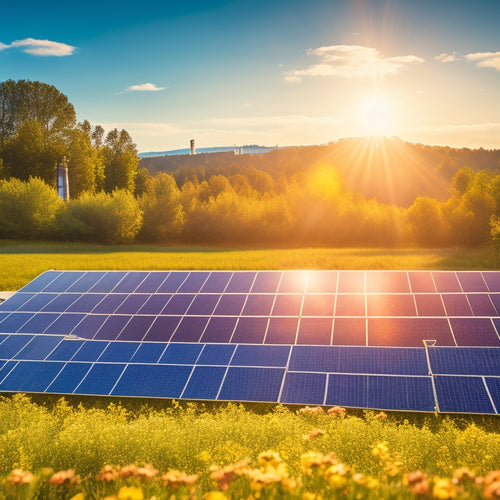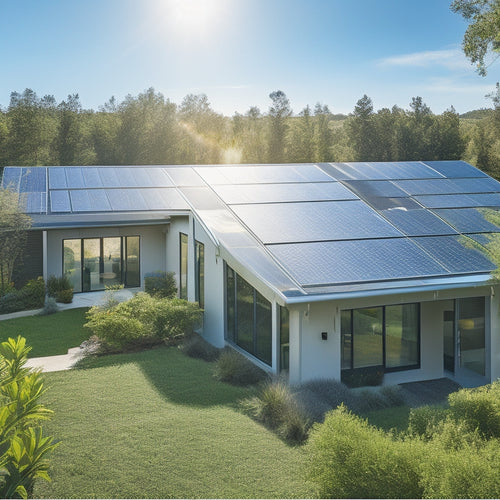
What's the Cost of Solar for Water Pumps?
Share
You'll need to evaluate several key factors when determining the cost of solar for water pumps, including system size, solar panel quality, battery and inverter expenses, installation and maintenance costs, and total cost of ownership analysis. The minimum power requirement for efficient operation is 100-200 watts, and the solar array must match your daily energy needs. The type and quality of solar panels, batteries, and inverters impact overall cost and energy output consistency. Balancing these factors will help you achieve ideal performance and minimize costs. As you weigh these considerations, you'll uncover the full scope of what it takes to power your water pump with solar.
Overview
- The cost of a solar-powered water pump system varies depending on the size of the system, required water flow rate, and pressure.
- Solar panels account for a significant portion of the overall cost, with monocrystalline panels being more expensive but efficient.
- Batteries and inverters are essential components that impact system cost and efficiency, with top-rated brands offering reliability and durability.
- Installation and maintenance costs, including labor and permits, can range from $1,000 to $3,000 and require regular maintenance for optimal performance.
- A total cost of ownership analysis is necessary to understand the system's operational efficiency, return on investment, and long-term financial planning.
System Size and Cost Factors
Typically, a solar-powered water pump system requires a minimum of 100 to 200 watts of power to operate efficiently.
You'll need to assess the size of your system based on your water pumping needs. A larger system will provide more power, but it'll also increase your upfront cost.
To guarantee peak performance, it's vital to size solar arrays to match total daily energy needs, factoring in peak sun hours and system losses.
You should aim to strike a balance between pump efficiency and energy savings. A more efficient pump will reduce your energy consumption, leading to lower operating costs over time.
When sizing your system, take into account factors like water flow rate, pressure, and lift requirements.
Solar Panel Costs Breakdown
When you break down the cost of a solar-powered water pump system, the solar panels themselves are a significant expense.
You'll need to evaluate the type and quality of solar panels, as they greatly impact the overall cost. For instance, reliable water supply is vital in rural areas, and selecting the right solar panels can guarantee consistent energy output.
There are two primary solar panel types: monocrystalline and polycrystalline. Monocrystalline panels are more efficient, with higher efficiency ratings (18-22%), but are also more expensive.
Polycrystalline panels have lower efficiency ratings (15-18%) but are more budget-friendly. Efficiency ratings directly affect the system's size and cost. Higher-efficiency panels require fewer units to generate the same power, reducing the overall system cost.
You'll need to balance panel efficiency with your budget to find the best solution for your water pump system.
Battery and Inverter Expenses
As you've selected the ideal solar panels for your water pump system, you'll need to evaluate the next essential components: batteries and inverters. These components greatly impact the overall cost and efficiency of your system.
When selecting batteries, consider top-rated brands like Tesla, LG, and SimpliPhi, which are recognized for their reliability and durability reliable online retailers. Batteries store excess energy generated by your solar panels during the day for use at night or during power outages. A longer battery lifespan means fewer replacements, reducing costs.
Inverters convert DC power from your solar panels to AC power for your water pump. Look for inverters with high efficiency ratings to minimize energy loss. A 95% efficient inverter, for example, loses only 5% of the energy it converts.
Balancing battery capacity with inverter efficiency is vital to optimize your system's performance and reduce costs.
Installation and Maintenance Costs
Installation and maintenance costs are a significant aspect of your solar-powered water pump system, and it's essential to factor them into your overall budget.
When calculating installation costs, consider the cost of installation permits, which vary depending on your location and system size. You'll also need to account for labor costs, which can range from $1,000 to $3,000, depending on the complexity of the installation.
To minimize maintenance costs, establish a regular maintenance schedule to guarantee your system operates efficiently. This includes inspecting and cleaning the panels, checking the inverter and electrical connections, and performing routine system checks.
Total Cost of Ownership Analysis
Calculate the total cost of ownership for your solar-powered water pump system by evaluating all the expenses incurred throughout its lifespan.
You'll need to factor in the initial investment, installation and maintenance costs, and the cost of replacement parts over time. This thorough analysis will give you a clear depiction of your system's operational efficiency and return on investment.
Be sure to assess the system's performance, energy output, and any potential downtime or repairs.
Frequently Asked Questions
Can I Use Solar Power for Irrigation Pumps With AC Motors?
You can power AC motor irrigation pumps with solar energy, but it's essential to evaluate solar panel efficiency and pump performance to guarantee a reliable, efficient system that meets your water pumping needs.
How Does Solar Pumping Compare to Traditional Diesel Pumping?
You'll find that solar pumping surpasses traditional diesel pumping in silent sophistication, allowing for a seamless efficiency analysis and cost comparison that reveals a significant reduction in operational expenses, granting you the freedom to focus on your farm's growth.
Are There Any Government Incentives for Solar Water Pumps?
You'll be pleased to know that you can take advantage of government grants and tax rebates to offset the cost of solar water pumps, making them a more feasible option for your water management needs.
Can I Monitor and Control My Solar Water Pump Remotely?
Like having a personal assistant, you can remotely monitor and control your solar water pump's performance using advanced solar pump controllers, giving you real-time observations and freedom to optimize energy usage from anywhere, at any time.
Are Solar Water Pumps Suitable for Small-Scale Farming Applications?
You'll find solar water pumps well-suited for small-scale farming applications, offering sustainability benefits like reduced energy costs and environmental impact. Guarantee successful installation by considering factors like water depth, flow rate, and pump size to meet your specific requirements.
Ready to Buy
As you weigh the costs of solar for water pumps, remember that every dollar spent is like planting a seed in fertile soil - it'll yield a bountiful harvest of savings over time. In fact, a study by the International Renewable Energy Agency found that solar-powered water pumps can save farmers up to $1,400 annually on energy costs. With the total cost of ownership in mind, investing in solar for water pumps is a wise decision that'll reap dividends for years to come.
Related Posts
-

Advantages of Solar Generating Systems Over Traditional Energy
Solar generating systems provide several key advantages over traditional energy sources. You'll experience lower long...
-

Key Components of a Reliable Emergency Power Supply System
A reliable emergency power supply system requires several key components. You need proven performance metrics to guar...
-

Installing Metal Solar Roofs for Maximum Energy Efficiency
Installing metal solar roofs can drastically enhance your home's energy efficiency and durability. These roofs withst...


